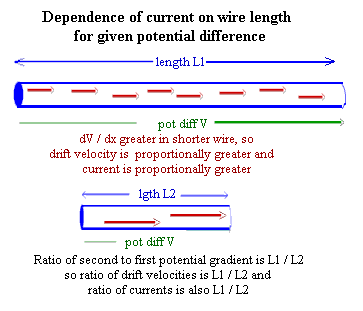
Problem: Two uniform wires having circular cross-sections, both with the same length and made of identical material, are both maintained at the same potential difference and the same temperature. The first wire has diameter 7.75, while the second has diameter 6.975. If the current in the first wire is 8 amps, then what is the current in the second wire?
.
.
.
.
.
.
.
.
.
.
.
.
.
.
.
.
.
.
.
.
.
.
.
.
.
.
.
.
.
.
Solution: Since the potential differences and the lengths of the wires are identical the potential gradients, or electric fields, will be identical. Thus the drift velocities will be equal. Since the second wire has 6.975 / 7.75 = .9000 the diameter of the first, it will have ( 6.975 / 7.75)^2 = ( .9000) ^2 = .8009 the cross-sectional area of the first. It will therefore have .8009 times as many electrons per unit length available to carry the current. Thus the drift of electrons will carry .8009 times as many electrons past a given point every second. The current in the second wire will therefore be .8009 * 8 amps = 6.407 amps.
Generalized Response: If wires having uniform circular cross-sections are of identical length and have the same potential difference from end to end, with one wire having diameter d1 and the other diameter d2, then the cross-sectional area of the second is (d2 / d1) ^ 2 times that of the first. The second wire will therefore have (d2 / d1) ^ 2 times as many available charge carriers per unit length. Since the drift velocity depends only on the potential gradient, the drift velocities are the same. It follows that in any given time interval, the number of electrons drifting past a point in wire 2 is (d2 / d1) ^ 2 times as great as in wire 1. The current in wire 2 is therefore (d2 / d1) ^ 2 times as great as in wire 1.
.
.
.
.
.
.
.
.
.
.
Figure description: The figure below shows two wires of different lengths with the same potential difference V between their ends. The potential gradient E = dV / dx is greater in the shorter wire, so the drift velocity is higher. The higher drift velocity implies a proportionally higher current.